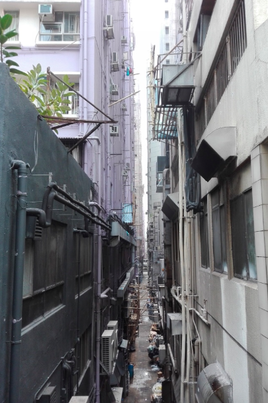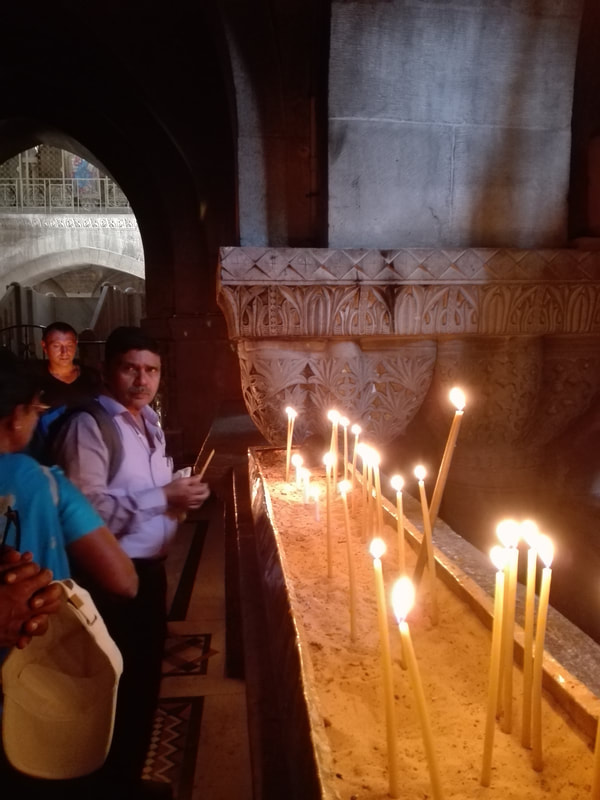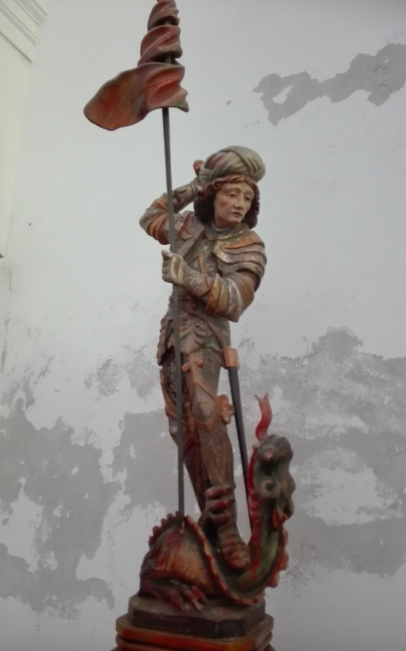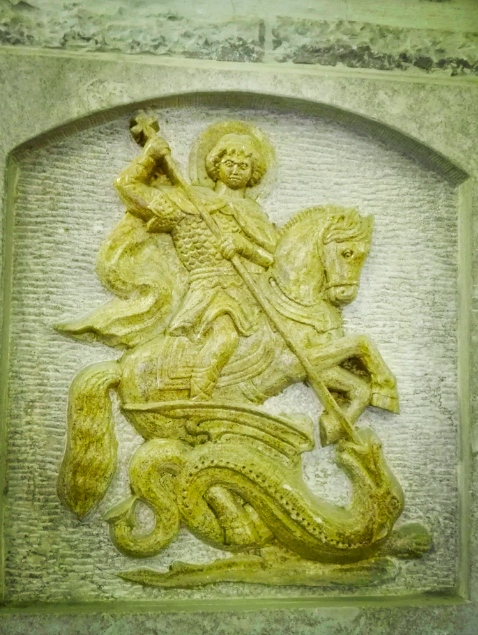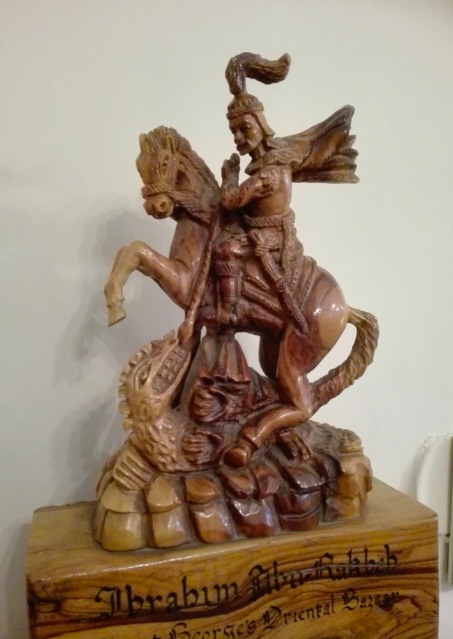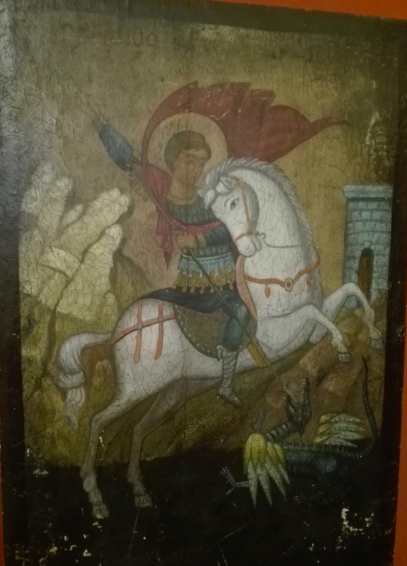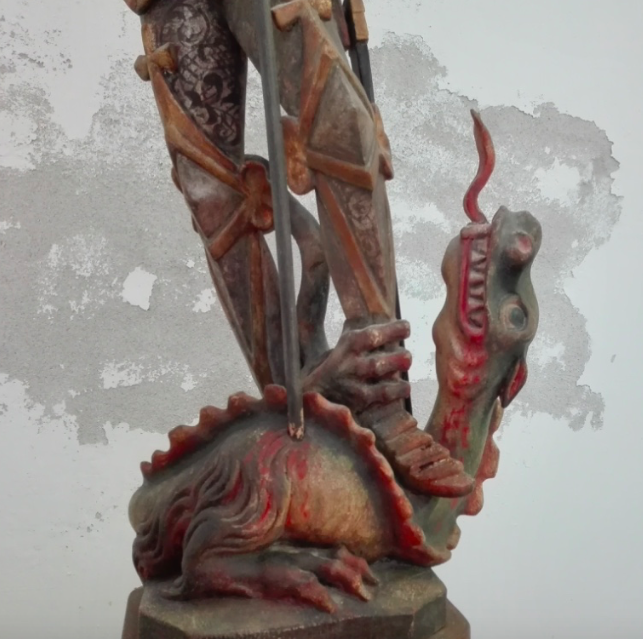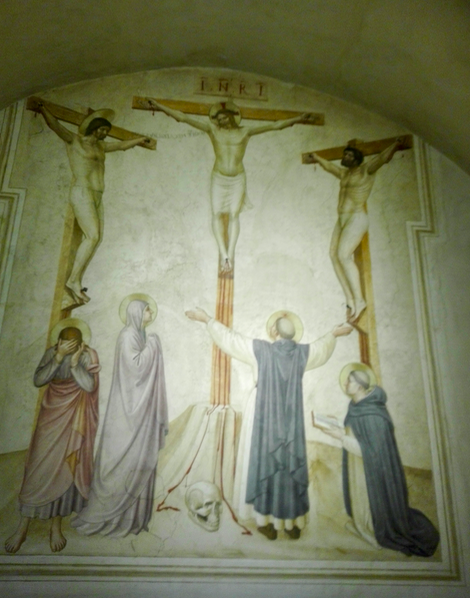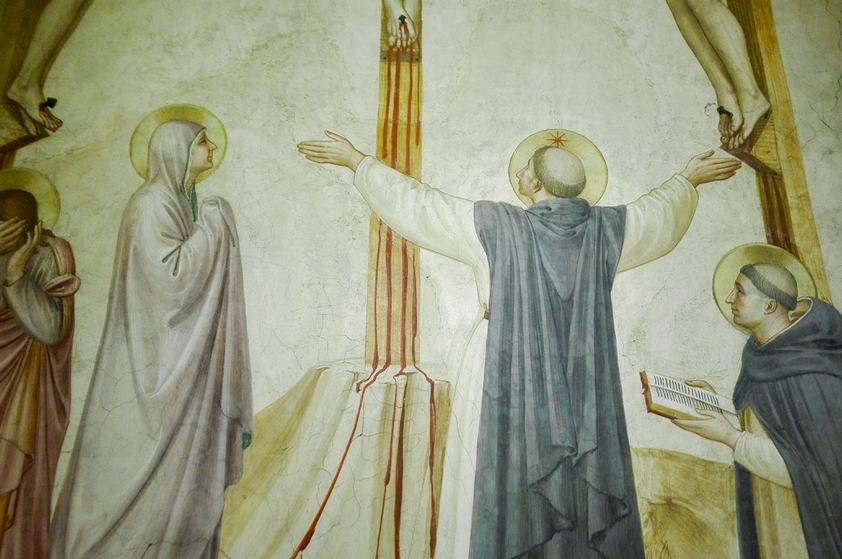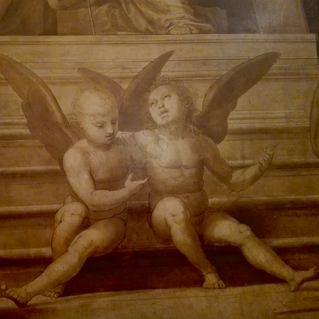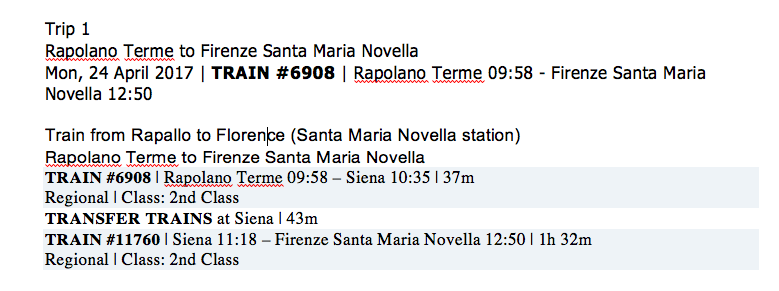|
Looking deeper ...
I'm wanting to go back and delve more into some of my trip photos. I wonder if you'd like to share in this with me. Mostly I tried to avoid including other people in my photos, but now the people who found their way into the edges of my photos are starting to intrigue me. There are 4 people caught in this photo. We are in one of the many passage-ways in the Church of the Holy Sepulcher, Jerusalem. You can get a glimpse through the arch-way of the crazy complexity that is that bizarre church, churches within churches, a mad mis-match of stones, pillars, stairs & tunnels. The man in the purple shirt is about to light a candle but he is looking back, waiting for someone. All you can see of the person closest to me is hands folded in prayer, and his cap. His dark skin suggests he has, like me, travelled from far away to be at this very spot. His hands express a sense of the presence of God in a prayerful way. He has stopped, focused. The woman in the blue top is walking past, only glancing at the candles, part of the moving press of people. And the man furthest away, his face is lit by candle glow - perhaps he is carrying a flame, and he is looking at it intently. These people, each from a very different part of the world, passing in this strange and wonderful place, in candle light. How does this picture touch you? What questions do you ask of it? I am drawn to the contrast between the ancient stone and the fleeting step of us passing through it. Now we are all gone from there, gone home to our very different lives, and that place remains, those candles burnt to be replaced by fresh ones every day. How is God revealed in this image? |
Lord, illuminate me
I want to glow with you Lord, pray in me I am a tiny part of your people of prayer in every corner of the world Lord, stop me make me stand and be held in this moment in your presence, knowing you only you and the light of your face. Amen. |
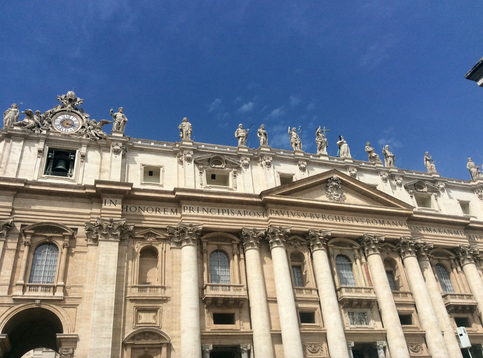
History and Place
So, I’ve been thinking - why did I choose those places to visit, when I could have gone anywhere in the world? What drew me to where I went?
I could have gone to mountains, canyons, reefs or waterfalls, but I chose cities and cathedrals. I could have gone somewhere utterly new, strange and wonderful, Morocco, Nepal or Madagascar, but I went to where I already had been, where I already knew people and stories.
My answer to the question revolves around places of importance to me, my culture, my faith, my heritage, my whanau. Importance. Significance. On my travels I found myself wanting to describe places as the biggest or the oldest or the most important. I wanted to enter into spaces which shaped history, my history, who I am and the world that I know.
I live in the youngest nation on earth. This land of Aotearoa New Zealand has been inhabited by humanity for only 1,000 years, and by europeans for 200 years. Even the birds only came here relatively recently, blown across the ditch from Australia … and there were practically no mammals other than whales and dolphins until the rats jumped ship. Even the land itself is young, having split itself off from big brother Ozzy relatively recently, then spent much of its history under water.
And New Zealanders aren’t renowned for their interest in history, the Pakeha ones anyway, we whose ancestors left their homes and their histories behind and didn’t go back. It is our Maori friends who value their history, who keep the past in their sight as they walk backwards into the future, and they ask of us Pakeha that we know who we are and where we came from.
If we do not stand in the land from which we came how can we tell stories of it? If we do not experience Israel first-hand how can we describe it any differently to how it has been described to us?
So, I chose places of importance to my faith and my culture. Israel, of course, the focus of this trip; Jerusalem, the centre of the world, so they say. Italy, for the connection with the woman I am named after, and for the beauty of her home. Florence, because everyone raves about Florence. Rome, the heart of empire and Christian faith for 1 1/2 millennia. London, the centre of a different empire and faith. Turvey, where my ancestors came from (one branch anyway). San Francisco to see my cousin, and a piece of American history. So what did I learn about what has shaped my culture and my faith?
Everywhere there is a curious mix of religion and politics. So much for our modern ideas about secular politics and personal spirituality. From Canaanite worship 10,000 years ago, to King Jeroboam of Israel who set up a golden calf in Dan in competition with Jerusalem (1 Kings 12 - we stood on the actual place it stood), to King Herod building a temple to Caesar at Caesarea Philippi just up the road. There was Empress Helena arriving to build churches in 326, when Christianity suddenly went from outlawed to official, solidifying Constantine’s unified empire. There was … building Westminster Abbey to the glory of God and Britain, and Michelangelo building the biggest dome in the world to the glory of God and Rome. There in Turvey the impressively large parish church was fully funded by the local lord while the villagers lived in poverty, and in Sonoma in northern California the Spanish Mission was built right next door to the Mexican military headquarters. To the Jewish young people doing military service, machine guns casually swung over their shoulders as they walk through town.
All of it seems a long way removed from a Palestinian preacher who avoided the big towns on the whole and chose humble people in a back corner of the world, by the lake and up the hill, to reveal the glory of God first-hand. Seeing Jesus and his chosen 12 in huge statues looking down on the plaza in front of St Peters in Rome, they seem less than real. Those wonderfully dynamic flawed first disciples, so interesting and human in the gospel stories, stand there imperiously like Greek Gods in the Pantheon (they're all holding weapons, by the way). Politics, power and wealth has a way of stripping the heart out of faith and replacing it with trappings of earthly majesty. When scripture is backed up with swords or guns, what happens to the Word?
I sound uneasy, but I am also impressed by the incredible feats of art and architecture that Christendom has produced. Many were utterly awe-inspiring, much was amazingly beautiful. I’m just still grappling with what, if anything, it all reveals about Jesus Christ, his teaching, his Father and his Spirit. Perhaps that’s why I took photos of small things, little details, a curve of metal in a gate, a face in a painting, a single flower carved in wood. Perhaps the bigness of the grand churches and empires was all too much for my soul and I looked for God in a smaller scale. Sure, some rich person paid for it. Sure, it played a role in endorsing some political system or other. But the tender touch of artistry proclaims the Creator Spirit, no matter who’s paying.
History is just people after all, human beings doing their best where they are, whether they are painstakingly making lace by a flickering candle in an English village or forging empires and controlling armies. We can look back and mourn the disasters of destruction and violence. We can admire vision and courage and sacrifice. We can look for the hand of God at work. History is a long and complex mesh of stories grounded in places. I hope I am the richer for being in few of them for just a moment.
So, I’ve been thinking - why did I choose those places to visit, when I could have gone anywhere in the world? What drew me to where I went?
I could have gone to mountains, canyons, reefs or waterfalls, but I chose cities and cathedrals. I could have gone somewhere utterly new, strange and wonderful, Morocco, Nepal or Madagascar, but I went to where I already had been, where I already knew people and stories.
My answer to the question revolves around places of importance to me, my culture, my faith, my heritage, my whanau. Importance. Significance. On my travels I found myself wanting to describe places as the biggest or the oldest or the most important. I wanted to enter into spaces which shaped history, my history, who I am and the world that I know.
I live in the youngest nation on earth. This land of Aotearoa New Zealand has been inhabited by humanity for only 1,000 years, and by europeans for 200 years. Even the birds only came here relatively recently, blown across the ditch from Australia … and there were practically no mammals other than whales and dolphins until the rats jumped ship. Even the land itself is young, having split itself off from big brother Ozzy relatively recently, then spent much of its history under water.
And New Zealanders aren’t renowned for their interest in history, the Pakeha ones anyway, we whose ancestors left their homes and their histories behind and didn’t go back. It is our Maori friends who value their history, who keep the past in their sight as they walk backwards into the future, and they ask of us Pakeha that we know who we are and where we came from.
If we do not stand in the land from which we came how can we tell stories of it? If we do not experience Israel first-hand how can we describe it any differently to how it has been described to us?
So, I chose places of importance to my faith and my culture. Israel, of course, the focus of this trip; Jerusalem, the centre of the world, so they say. Italy, for the connection with the woman I am named after, and for the beauty of her home. Florence, because everyone raves about Florence. Rome, the heart of empire and Christian faith for 1 1/2 millennia. London, the centre of a different empire and faith. Turvey, where my ancestors came from (one branch anyway). San Francisco to see my cousin, and a piece of American history. So what did I learn about what has shaped my culture and my faith?
Everywhere there is a curious mix of religion and politics. So much for our modern ideas about secular politics and personal spirituality. From Canaanite worship 10,000 years ago, to King Jeroboam of Israel who set up a golden calf in Dan in competition with Jerusalem (1 Kings 12 - we stood on the actual place it stood), to King Herod building a temple to Caesar at Caesarea Philippi just up the road. There was Empress Helena arriving to build churches in 326, when Christianity suddenly went from outlawed to official, solidifying Constantine’s unified empire. There was … building Westminster Abbey to the glory of God and Britain, and Michelangelo building the biggest dome in the world to the glory of God and Rome. There in Turvey the impressively large parish church was fully funded by the local lord while the villagers lived in poverty, and in Sonoma in northern California the Spanish Mission was built right next door to the Mexican military headquarters. To the Jewish young people doing military service, machine guns casually swung over their shoulders as they walk through town.
All of it seems a long way removed from a Palestinian preacher who avoided the big towns on the whole and chose humble people in a back corner of the world, by the lake and up the hill, to reveal the glory of God first-hand. Seeing Jesus and his chosen 12 in huge statues looking down on the plaza in front of St Peters in Rome, they seem less than real. Those wonderfully dynamic flawed first disciples, so interesting and human in the gospel stories, stand there imperiously like Greek Gods in the Pantheon (they're all holding weapons, by the way). Politics, power and wealth has a way of stripping the heart out of faith and replacing it with trappings of earthly majesty. When scripture is backed up with swords or guns, what happens to the Word?
I sound uneasy, but I am also impressed by the incredible feats of art and architecture that Christendom has produced. Many were utterly awe-inspiring, much was amazingly beautiful. I’m just still grappling with what, if anything, it all reveals about Jesus Christ, his teaching, his Father and his Spirit. Perhaps that’s why I took photos of small things, little details, a curve of metal in a gate, a face in a painting, a single flower carved in wood. Perhaps the bigness of the grand churches and empires was all too much for my soul and I looked for God in a smaller scale. Sure, some rich person paid for it. Sure, it played a role in endorsing some political system or other. But the tender touch of artistry proclaims the Creator Spirit, no matter who’s paying.
History is just people after all, human beings doing their best where they are, whether they are painstakingly making lace by a flickering candle in an English village or forging empires and controlling armies. We can look back and mourn the disasters of destruction and violence. We can admire vision and courage and sacrifice. We can look for the hand of God at work. History is a long and complex mesh of stories grounded in places. I hope I am the richer for being in few of them for just a moment.
London Worship: 3 extremes
(the photos that go with this are in the England page)
I made sure while booking that we had a whole Sunday in London, and we certainly made the most of it. Three churches, three worship services, three completely different styles, traditions, theologies and communities, despite all three being Anglican, and all three worshiping in very traditional old church buildings. Each one was superb in its own frame. Each one has global connections and influence.
1. Holy Trinity Brompton. I’ve been wanting to go to ‘HTB’ for years, ever since I’ve been part of the New Wine community. We were not disappointed. It was awesome!! As Ben describes it, “You could feel the Spirit of God within 5 minutes. It was emotion, from the heart.” We are familiar with the HTB-New Wine worship format: intro, 3 worship songs drawing heat and movement, a speaker who also reads the scripture, a call to response, the offer of prayer ministry, more music to create space for prayer at the end. Very simple format, with high tech stage rig (the glorious ancient stained glass is now all but covered over with screen & coloured light strips). Very professional, superb preaching. Very accessible, speaking about and into people’s everyday lives, to non-believers and to established Christians. Very warm, relational, informal dress (denim shirts seemed to be the dress code), practical, personal, lively. The church was literally packed to the rafters.
HTB’s global impact has been vast, especially through Alpha in all its versions. Mind bogglingly enormous. A huge factor in churches defying decline in every nation.
2. Westminster Abbey. It certainly is an experience to enter this church. It might not be the biggest church in the world this was a church built to be the centre of the world, the heart of empire, the seat of power both religious and secular. No other building represents (for us children of the British Empire anyway) the merged glory of God and Man, wealth and status and national identity infused with the divine. This is the site of the King of Kings, where stone has been stretched as high as high can be, into arches of light lifting up so that light falls around altar and throne.
We went to Evensong, at 3pm, and the seating was full, tourists like us mostly. Ben was unimpressed. He has no time for prayers said just the same last week as this week as last century, they move him not a jot. I struggled with the ‘thees’ and ‘thous’, not used to them! It’s a strange building to sit in, because it’s all so screened off with different sections not in relationship with each other. It’s a strange church to move in because it is so highly policed, with men in red robes tightly directing, forbidding photos, looking stern. Then into that ultimate formality up steps a young black woman to preach, short and spunky, hair plaited tight to her scalp, one Venerable Elizabeth, speaking of death and life, her voice well practiced in speaking into that vast echoing space. I could hardly believe it, what a curious juxtaposition of cultural change and cultural intransigence. (What even is a ‘venerable’? – that’s different from being a Canon?)
3. St James Piccadilli, Gospel service. 5.30pm saw Ben and I sitting on the steps at St James, just along from The Ritz, eating most delicious sticky substances from the patissiere, watching them set up for their outdoor Gospel Eucharist. Until it started raining, then it was everyone (including us) racing to get all the sound gear, altar cloths & candles inside the church before they got soaked!
6.10pm the service started (a little later than planned, and relocated inside, which suited us quite well because inside they use the grand piano and it was a very lovely open space inside under a long curved roof), lead by Soul Sanctuary Gospel Choir. Wow. We loved it. The Choir get together for the occasional evening service, and they’ve made some recordings. They are very good, just what we were hoping for and more.
The two church priests were both youngish white women. Purely on the basis that they both had short cropped hair and no makeup, my assumption based purely on stereotypes is that they might be respectful of alternative lifestyles, shall we say. I got talking to the one who is the Rector (what even is a Rector?) about the unique challenges of a church situated among some of the most expensive real estate on the planet but working with the homeless and sustaining a living congregation. Fascinating.
So, what do I think, after these three extreme points on a triangle of the one religion?
I think that Westminster Abbey is as far removed from Capernaum as you could get. It is indeed a stretch to connect together the seat of global royalty with the Palestinian preacher-man who chose little fishing towns and empty hillsides out the back of beyond.
I think that you can do church without community but you cannot be church. One of the things I loved most about HTB was that everybody in the room was fully engaged. It was a wonderful mix of ages and ethnicities, and a lot of people, and as I looked around during worship everyone was moving, singing, praying. No one was a spectator (not that I noticed anyway). Not so at Westminster, where there was no interaction, and most were there (as we were) as tourists, for the free entry and choir concert. I’m sure there were some regulars but most were there as spectators. As for St James, I was disappointed that people coming sat themselves as far from each other as they could, so the few dozen people attending were well scattered through the large church. One of the gospel choir commented to me afterwards how much she’d appreciated me moving and obviously enjoying their music, as most of the congregation don’t. Fits my stereotypes of British reserve, but I might have thought that if you go to a Gospel Eucharist you’d go willing to get into the groove!
So, three very different experiences of community participation in worship. While I respect the need of introverts for worship to be a ‘non-contact sport’, I am convinced that worship is far more likely to be transformative in people’s lives where there is a high level of genuine community, where love is tangible and where you are invited into deep relationship.
(the photos that go with this are in the England page)
I made sure while booking that we had a whole Sunday in London, and we certainly made the most of it. Three churches, three worship services, three completely different styles, traditions, theologies and communities, despite all three being Anglican, and all three worshiping in very traditional old church buildings. Each one was superb in its own frame. Each one has global connections and influence.
1. Holy Trinity Brompton. I’ve been wanting to go to ‘HTB’ for years, ever since I’ve been part of the New Wine community. We were not disappointed. It was awesome!! As Ben describes it, “You could feel the Spirit of God within 5 minutes. It was emotion, from the heart.” We are familiar with the HTB-New Wine worship format: intro, 3 worship songs drawing heat and movement, a speaker who also reads the scripture, a call to response, the offer of prayer ministry, more music to create space for prayer at the end. Very simple format, with high tech stage rig (the glorious ancient stained glass is now all but covered over with screen & coloured light strips). Very professional, superb preaching. Very accessible, speaking about and into people’s everyday lives, to non-believers and to established Christians. Very warm, relational, informal dress (denim shirts seemed to be the dress code), practical, personal, lively. The church was literally packed to the rafters.
HTB’s global impact has been vast, especially through Alpha in all its versions. Mind bogglingly enormous. A huge factor in churches defying decline in every nation.
2. Westminster Abbey. It certainly is an experience to enter this church. It might not be the biggest church in the world this was a church built to be the centre of the world, the heart of empire, the seat of power both religious and secular. No other building represents (for us children of the British Empire anyway) the merged glory of God and Man, wealth and status and national identity infused with the divine. This is the site of the King of Kings, where stone has been stretched as high as high can be, into arches of light lifting up so that light falls around altar and throne.
We went to Evensong, at 3pm, and the seating was full, tourists like us mostly. Ben was unimpressed. He has no time for prayers said just the same last week as this week as last century, they move him not a jot. I struggled with the ‘thees’ and ‘thous’, not used to them! It’s a strange building to sit in, because it’s all so screened off with different sections not in relationship with each other. It’s a strange church to move in because it is so highly policed, with men in red robes tightly directing, forbidding photos, looking stern. Then into that ultimate formality up steps a young black woman to preach, short and spunky, hair plaited tight to her scalp, one Venerable Elizabeth, speaking of death and life, her voice well practiced in speaking into that vast echoing space. I could hardly believe it, what a curious juxtaposition of cultural change and cultural intransigence. (What even is a ‘venerable’? – that’s different from being a Canon?)
3. St James Piccadilli, Gospel service. 5.30pm saw Ben and I sitting on the steps at St James, just along from The Ritz, eating most delicious sticky substances from the patissiere, watching them set up for their outdoor Gospel Eucharist. Until it started raining, then it was everyone (including us) racing to get all the sound gear, altar cloths & candles inside the church before they got soaked!
6.10pm the service started (a little later than planned, and relocated inside, which suited us quite well because inside they use the grand piano and it was a very lovely open space inside under a long curved roof), lead by Soul Sanctuary Gospel Choir. Wow. We loved it. The Choir get together for the occasional evening service, and they’ve made some recordings. They are very good, just what we were hoping for and more.
The two church priests were both youngish white women. Purely on the basis that they both had short cropped hair and no makeup, my assumption based purely on stereotypes is that they might be respectful of alternative lifestyles, shall we say. I got talking to the one who is the Rector (what even is a Rector?) about the unique challenges of a church situated among some of the most expensive real estate on the planet but working with the homeless and sustaining a living congregation. Fascinating.
So, what do I think, after these three extreme points on a triangle of the one religion?
I think that Westminster Abbey is as far removed from Capernaum as you could get. It is indeed a stretch to connect together the seat of global royalty with the Palestinian preacher-man who chose little fishing towns and empty hillsides out the back of beyond.
I think that you can do church without community but you cannot be church. One of the things I loved most about HTB was that everybody in the room was fully engaged. It was a wonderful mix of ages and ethnicities, and a lot of people, and as I looked around during worship everyone was moving, singing, praying. No one was a spectator (not that I noticed anyway). Not so at Westminster, where there was no interaction, and most were there (as we were) as tourists, for the free entry and choir concert. I’m sure there were some regulars but most were there as spectators. As for St James, I was disappointed that people coming sat themselves as far from each other as they could, so the few dozen people attending were well scattered through the large church. One of the gospel choir commented to me afterwards how much she’d appreciated me moving and obviously enjoying their music, as most of the congregation don’t. Fits my stereotypes of British reserve, but I might have thought that if you go to a Gospel Eucharist you’d go willing to get into the groove!
So, three very different experiences of community participation in worship. While I respect the need of introverts for worship to be a ‘non-contact sport’, I am convinced that worship is far more likely to be transformative in people’s lives where there is a high level of genuine community, where love is tangible and where you are invited into deep relationship.
|
St George and his Dragon
I have something of a collection of images of St George and the dragon. It was common in Italy, especially in Portofino where he is their patron saint, and of course in St George’s in Jerusalem. I understand his appeal, for people under threat or engaged in ‘holy war’. But I can’t say I like him, up there on his white charger, violently and pompously stabbing the writhing dragon at his feet. Mostly I feel sorry for the dragon. Feminists have seen this image as a mascot for patriarchy, with the dragon archetypally seen as a symbol for the feminine. The spear is a phallic symbol, obviously. The Crusaders loved St George, and all too often their conquests involved rape and murder, as do most self-appointed ‘holy warriors’. I have been thinking on the trip quite a lot about violence and moral authority, and St George seems to lie at the heart of the question. Does God call us to fight? If so, against what, and how? Over and over again in our history people of faith have taken up the weapons of the age and in the process of battle depersonalised their chosen enemy. It’s OK to kill a snake or a dragon, but what about another person that you see as a snake or dragon? Is it self-defence? Would the dragon kill George if given the opportunity? Is it teeth, claw and fire vs spear and sword, one must conquer the other? This question is deeply relevant to modern Israel. Many Jews are convinced that all Arabs are out to kill all Jews and to destroy Israel, which drives the military response to Palestinian communities (I know this sounds harsh but this very was explicitly and forcefully expressed to Ben and I in our taxi ride to the airport by an American Jew who had overheard my conversation with Ben reflecting on our time in Israel and wanted to put Ben straight). The Christian church is deeply divided, and has been for many years, about the God’s attitude to violence. The Christians who voted for Trump and against gun control clearly believe that they are morally and religiously justified in carrying weapons and potentially using them against an aggressor, like St George attacking the dragon. St George’s Cathedral in Jerusalem is the base for a regional Anglican church which is very active in working for peace, promoting friendship between cultures and faiths. But St George on the walls seems incongruous to the passion for peace. I was brought up in a pacifist home, but people who sacrificed much for their conviction that violence is never the answer. I am married to an Army chaplain, who is trained in the use of guns and keeps a collection of very sharp knives in the wardrobe. I choose to support Israel but I struggle with their use of force against many living within their borders. I am particularly intrigued by this statue below, in Portofino. This image is a more intimate encounter between George and the dragon; the dragon has a grip on his leg, and George has not yet run him through. If we see the dragon as a symbol of evil and sin, this is an interesting theological dilemma. Perhaps St George is a figure for Jesus, the ultimate victor over evil and sin. But Jesus gained the victory not from the security of a white horse, not at arm’s length with a spear. Jesus himself was stabbed with the spear. Jesus himself was run through on the cross. His victory comes not through inflicting violence on others but by himself being the victim of violence. |
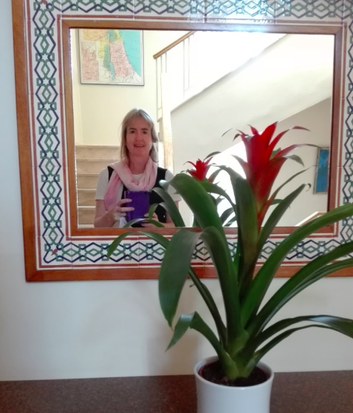
Taking Photos
A reflection
When we began our Israel course at St Georges College the tutor suggested to us that we shouldn’t worry too much about taking photos. Best to focus on being in a place, seeing it with our own eyes rather than through a lens. I quite agreed with him. I have no respect for tourists who arrive somewhere spectacular, rush around taking photos of each other in front of it, then leave for the next one, as through the whole purpose of international travel is a collection of selfies with different backgrounds (surely these days one can do this easy enough with photoshop!). But I found myself taking lots of photos, and I’m curious about why.
This past month’s travel, especially in Israel, created thousands of moments when I stepped into a space I had never been before. Each of these moments was an assault on the senses, so much to be aware of all at once. I would look around, up, below, inside, outside. My camera helped me to do this. One needs a way to focus, a way to see, or it all becomes a blur.
In an exhibition in London (of atmospheric photos of ship models) this quote was on the wall, from Marcel Prout: “The real voyage of discovery consists not in seeing new landscapes but in having new eyes.”
My ‘new eyes’ this journey has been an intensity of seeing, a particular curiosity about what stands out for me. I found myself drawn to symmetry, framing up photos as much as I could balanced and clean lines. I was drawn to the square shape to catch a sweet detail that other people just walked past. I was drawn to images of women expressing passion, beauty or something quirky (and I have written about some of these in my ‘Lovely Ladies’ section). I liked to combine a close foreground with a contrasting background, e.g. sitting under an olive tree on the Mount of Olives appreciating the wild red poppies growing out of the rough earth with Mt Zion gleaming behind in the sunlight. Apart from particular people at particular times, I found myself trying to avoid getting people in my photos, being more interested in the patterns and light of the objects in the space. I found myself wanting to tell stories with my photos, so that they would speak to other people, requiring that things be set in context. Each photo comes with its own narrative, some many layers of narrative.
Spiritual disciplines are always about limitations as well as focused attention. In this case, I was limited by my camera. I decided to just use my cell phone camera, which does not have a zoom but is quite good close up. Anything more than a few feet away loses detail. And the second delay is useless for movement.
So I could not take photos of a sleek deep blue hummingbird in the tree at St George’s, or the bats which swooped in the moonlight.
Two regrets. I wish we could have stood on a field. We passed fields with birds eating the seed. We passed shepherds walking a small herd of goats. But we could not stop so I could not take a photo. I also wish we could have stood in the wilderness, with only rocks and sand stretching away beyond. But these lands are occupied territories. The wilderness has land mines in it, and farmers would not welcome a van-load of strangers on their land.
Another regret. I wish I could have photographed the stone. So many types of stone, some rough, so much worn smooth by human tools and hands over so many years. Some rock cracked, some with moss or other plants colonizing it. Silvery rock, reddish rock, yellowish rock. Some rock in Italy incredible colours and patterns. But photos of rock are deadly boring. Stone defies the small 2-dimensional space of the lens. Stone is by definition 3 dimensional.
Other things which I could not catch in a photo:
-the feel of a hug expressing friendship that cannot be what it might be
-the taste of an icecream
-the smell of a cave in which candles have been lit every day for hundreds of years
To go back to my photos, I wonder how they express God. If my taking of them was a form of prayer, how have they enhanced my eyes of faith? I hope to keep working with my collection of photos, seeing new things in them, and allowing Christ to emerge from within them, out of these things I have seen.
A reflection
When we began our Israel course at St Georges College the tutor suggested to us that we shouldn’t worry too much about taking photos. Best to focus on being in a place, seeing it with our own eyes rather than through a lens. I quite agreed with him. I have no respect for tourists who arrive somewhere spectacular, rush around taking photos of each other in front of it, then leave for the next one, as through the whole purpose of international travel is a collection of selfies with different backgrounds (surely these days one can do this easy enough with photoshop!). But I found myself taking lots of photos, and I’m curious about why.
This past month’s travel, especially in Israel, created thousands of moments when I stepped into a space I had never been before. Each of these moments was an assault on the senses, so much to be aware of all at once. I would look around, up, below, inside, outside. My camera helped me to do this. One needs a way to focus, a way to see, or it all becomes a blur.
In an exhibition in London (of atmospheric photos of ship models) this quote was on the wall, from Marcel Prout: “The real voyage of discovery consists not in seeing new landscapes but in having new eyes.”
My ‘new eyes’ this journey has been an intensity of seeing, a particular curiosity about what stands out for me. I found myself drawn to symmetry, framing up photos as much as I could balanced and clean lines. I was drawn to the square shape to catch a sweet detail that other people just walked past. I was drawn to images of women expressing passion, beauty or something quirky (and I have written about some of these in my ‘Lovely Ladies’ section). I liked to combine a close foreground with a contrasting background, e.g. sitting under an olive tree on the Mount of Olives appreciating the wild red poppies growing out of the rough earth with Mt Zion gleaming behind in the sunlight. Apart from particular people at particular times, I found myself trying to avoid getting people in my photos, being more interested in the patterns and light of the objects in the space. I found myself wanting to tell stories with my photos, so that they would speak to other people, requiring that things be set in context. Each photo comes with its own narrative, some many layers of narrative.
Spiritual disciplines are always about limitations as well as focused attention. In this case, I was limited by my camera. I decided to just use my cell phone camera, which does not have a zoom but is quite good close up. Anything more than a few feet away loses detail. And the second delay is useless for movement.
So I could not take photos of a sleek deep blue hummingbird in the tree at St George’s, or the bats which swooped in the moonlight.
Two regrets. I wish we could have stood on a field. We passed fields with birds eating the seed. We passed shepherds walking a small herd of goats. But we could not stop so I could not take a photo. I also wish we could have stood in the wilderness, with only rocks and sand stretching away beyond. But these lands are occupied territories. The wilderness has land mines in it, and farmers would not welcome a van-load of strangers on their land.
Another regret. I wish I could have photographed the stone. So many types of stone, some rough, so much worn smooth by human tools and hands over so many years. Some rock cracked, some with moss or other plants colonizing it. Silvery rock, reddish rock, yellowish rock. Some rock in Italy incredible colours and patterns. But photos of rock are deadly boring. Stone defies the small 2-dimensional space of the lens. Stone is by definition 3 dimensional.
Other things which I could not catch in a photo:
-the feel of a hug expressing friendship that cannot be what it might be
-the taste of an icecream
-the smell of a cave in which candles have been lit every day for hundreds of years
To go back to my photos, I wonder how they express God. If my taking of them was a form of prayer, how have they enhanced my eyes of faith? I hope to keep working with my collection of photos, seeing new things in them, and allowing Christ to emerge from within them, out of these things I have seen.
|
Fra. Antonio’s ‘At the foot of the cross’ fresco
Santa Marcos museum in Florence includes the upstairs dormitory rooms painted by Fr Antonio in the early 1500s. An entire wing is devoted to a similar image, Jesus on the cross, about 2 dozen frescos, one on each cell wall. I could have spent half a day sitting with each one. They are each complex sermons in pastoral theology. They depict heart and soul responses to the crucified Christ. This one in particular caught my eye. Four people are depicted, under Jesus and the 2 bandits: 2 monks, Mother Mary, and another man. The man on the left covers his eyes and his ears with both hands, turning away from Christ. It is a picture of anguish, perhaps even shame. ‘It’s all too much, I can’t take it anyore’. This is not a denial of the cross. It is an expression of faith, but it is faith in pain. If this person is me I know all too well the need to turn away from the suffering of the world, to withdraw into myself and be held by the Spirit, to connect in myself with the dying of Christ. Jesus’ mother stands still and looks up at her son. Her face is intent but tense. Her hands are wrapped in her shawl, clasped together, perhaps pleading, perhaps cold. The image of Mary is a deeply prayerful one, with a stillness gathered around herself like her shawl, perhaps also self-protective but fully aware, watching and waiting, holding the space. If this woman is me I am growing more able to wait patiently, to look steadily, to be wrapped around with grace even in the hard places. The central monk flings wide his hands, the only painting in which I saw this. He stands tall, faces the cross, with open hands but closed eyes. I am moved by this. It is a powerful prayerful position (that wouldn’t look out of place in a Pentecostal worship service!). I respond to it as an act of utter adoration, complete openness of heart. If this monk is me, I am flung wide open to Jesus Christ, wanting nothing by him, knowing nothing but Christ, and Christ crucified, as Paul puts it. The right-hand monk is quite different again. He is kneeling, facing toward the cross, leaning in toward it, with eyes open, but face unaffected by grief or agony. He holds a book. This monk is the scholar, the theologian, observing the crucifixion and searching the scriptures. he is reflecting on what he is seeing in the light of what he has received. If this is me I am open to see what I see, expecting that Christ will be all in all, and I am continually reflecting on what I have been taught, seeking points of connection and disconnection. This image speaks to me of the dialogue between living Word and written word that is such a key part of my role as parish minister. |
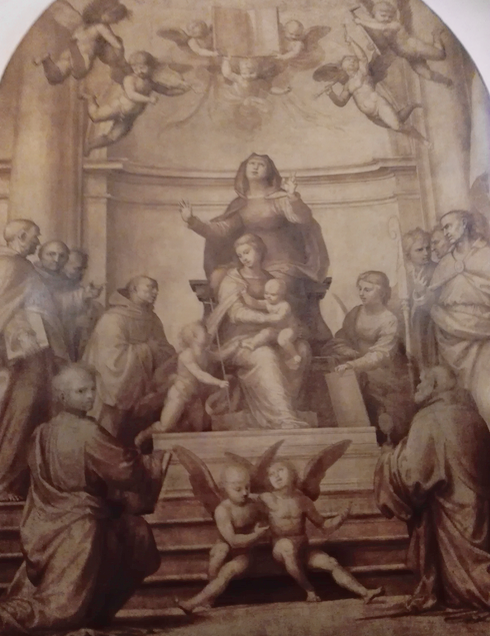
Theological Argument
unfinished large work: conversation about the immaculate conception
details … 3-faced head at top
I was most intrigued by this large work, especially by its history. It depicts a theological argument, a conversation between learned men about a controversial point of Marian theology, the ‘immaculate conception’ – i.e. how could she still be eternally a Virgin after giving birth (not to mention Jesus’ brothers and sisters who presumably were conceived in the traditional way! Or they could have been Joseph's kids from his first marriage.). Anyway, it doesn’t really matter what they were arguing about, the point is that this was a point of controversy in the church at the time, and the church permitted open debate and allowed people to hold different points of view, so it was at the time of painting a model for democratic process and handling conflict at a time when the civic leadership of the town had established a new Republic. Sadly the Republic imploded (so much for respectful conflict resolution) and the commission for the painting terminated, so it was never finished.
But it’s actually quite nice in this mono-tone unfinished state. It’s a lovely insight into the artistic process. And some of the details are fascinating.
I was most intrigued by a floating head right at the top which has 3 faces – I wondered it is was a depiction of the Trinity.
I loved the two cherubs at the bottom, I thought they are also engaged in the debate. If so isn’t that a great image of holding each other in affectionate friendship while also disagreeing? We assume, don’t we, that in heaven all truth will be revealed and all arguments resolved, and it’ll turn out that some of us were ‘more right than others’. But what if diversity is built into the very structure of both heaven and earth? Then again, once we gain the ultimate perspective on everything surely we will outgrow our own narrow points of view. It’s an interesting question. As for me, I am learning to be more comfortable with conflict, and respectful of conflict’s place in a living growing community. This painting helps with that.
unfinished large work: conversation about the immaculate conception
details … 3-faced head at top
I was most intrigued by this large work, especially by its history. It depicts a theological argument, a conversation between learned men about a controversial point of Marian theology, the ‘immaculate conception’ – i.e. how could she still be eternally a Virgin after giving birth (not to mention Jesus’ brothers and sisters who presumably were conceived in the traditional way! Or they could have been Joseph's kids from his first marriage.). Anyway, it doesn’t really matter what they were arguing about, the point is that this was a point of controversy in the church at the time, and the church permitted open debate and allowed people to hold different points of view, so it was at the time of painting a model for democratic process and handling conflict at a time when the civic leadership of the town had established a new Republic. Sadly the Republic imploded (so much for respectful conflict resolution) and the commission for the painting terminated, so it was never finished.
But it’s actually quite nice in this mono-tone unfinished state. It’s a lovely insight into the artistic process. And some of the details are fascinating.
I was most intrigued by a floating head right at the top which has 3 faces – I wondered it is was a depiction of the Trinity.
I loved the two cherubs at the bottom, I thought they are also engaged in the debate. If so isn’t that a great image of holding each other in affectionate friendship while also disagreeing? We assume, don’t we, that in heaven all truth will be revealed and all arguments resolved, and it’ll turn out that some of us were ‘more right than others’. But what if diversity is built into the very structure of both heaven and earth? Then again, once we gain the ultimate perspective on everything surely we will outgrow our own narrow points of view. It’s an interesting question. As for me, I am learning to be more comfortable with conflict, and respectful of conflict’s place in a living growing community. This painting helps with that.
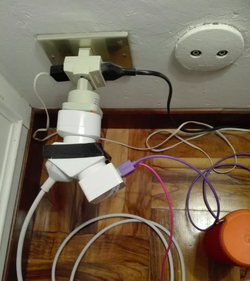
Plugs into plugs into plugs:
Communicating with God and across cultures
Here is our very own ‘tower of Babel’ … what a great picture of the complexities of communicating across cultures. Into the Italian plug in the wall is Silvia’s double plug for the bedside lights. Into that is our UK – Europe converter plug (bought in Hong Kong). Into that is our NZ-UK convertor (from my husband). Into that is our double plug (held together with tape), so that we can power up our 3 devices: laptop, my phone, Ben’s ipad.
How does electricity flow through so many connections? It is miraculous that it works at all. At each point it could be flawed or grounded or dissipated. I stressed about such things, at home, worrying that it wouldn’t work, that we would not be able to charge our things and they would be useless.
I have actually quite enjoyed the whole business of communicating across languages. Ben thinks I’m funny, which is no doubt true. I speak a strange version of English when talking to non-English speakers. It might well be just daft and patronising, but it does seem to work at getting across what I want to say, complete with hand gestures and exaggerated intonation. Italian is great fun as a language because the sounds are ‘over the top’ to our kiwi ears, each syllubul given its own importance, almost spat out. It is alive with colour and expression. Kiwi speak is so dull in comparison. And we leave out as many sounds as we possibly can and still be actual language. Italian adds in more … so ‘zz’ has an extra ‘t’ when said, a ‘c’ picks up a bonus ‘h’ before an ‘i’. Silvia was brought up Swiss, so native in both German and the local Swiss dialect, became fluent in Italian when her family moved here, then Sardinian dialect when she married a Sardinian, studied English and Spanish, even a little Russian.
Spiritually, this is about how we ‘plug in’ to God. We each have ways we are taught, ways we choose, of what makes sense to us. At Easter Camp Ben is learning one way to connect with God, through loud worship music and spoken communal prayers (he began on this journey with sore shoulders from so much time spent holding up his hands in praise!). He is also encouraged to grow in solo prayer and Bible study. I am blessed to have been trained a rich range of faith ‘plugs’. So when I attended worship at the St Francesco church in Rapallo I could understand much that was said, despite my lack of Italian, because I know the ancient patterns of worship. And whether or not I comprehended the words spoken, my spirit connected strongly with the spirit of the worship, and was wonderfully aware of the presence of the Holy Spirit. For this is the work of the Spirit, this flow of communication, overcoming the linguistic fragmentation of the Tower of Babel.
But still there are things that I cannot connect with. I find the devotional image of Santa Maria quite impenetrable. (more about that below). And I am very aware of the ways in which we as church put up barriers to the Spirit. The flow of living water, like the electricity between the mishmash of plugs, happens best with care, with affection, with commitment to relationship, with the steadying truth of scripture.
Communicating with God and across cultures
Here is our very own ‘tower of Babel’ … what a great picture of the complexities of communicating across cultures. Into the Italian plug in the wall is Silvia’s double plug for the bedside lights. Into that is our UK – Europe converter plug (bought in Hong Kong). Into that is our NZ-UK convertor (from my husband). Into that is our double plug (held together with tape), so that we can power up our 3 devices: laptop, my phone, Ben’s ipad.
How does electricity flow through so many connections? It is miraculous that it works at all. At each point it could be flawed or grounded or dissipated. I stressed about such things, at home, worrying that it wouldn’t work, that we would not be able to charge our things and they would be useless.
I have actually quite enjoyed the whole business of communicating across languages. Ben thinks I’m funny, which is no doubt true. I speak a strange version of English when talking to non-English speakers. It might well be just daft and patronising, but it does seem to work at getting across what I want to say, complete with hand gestures and exaggerated intonation. Italian is great fun as a language because the sounds are ‘over the top’ to our kiwi ears, each syllubul given its own importance, almost spat out. It is alive with colour and expression. Kiwi speak is so dull in comparison. And we leave out as many sounds as we possibly can and still be actual language. Italian adds in more … so ‘zz’ has an extra ‘t’ when said, a ‘c’ picks up a bonus ‘h’ before an ‘i’. Silvia was brought up Swiss, so native in both German and the local Swiss dialect, became fluent in Italian when her family moved here, then Sardinian dialect when she married a Sardinian, studied English and Spanish, even a little Russian.
Spiritually, this is about how we ‘plug in’ to God. We each have ways we are taught, ways we choose, of what makes sense to us. At Easter Camp Ben is learning one way to connect with God, through loud worship music and spoken communal prayers (he began on this journey with sore shoulders from so much time spent holding up his hands in praise!). He is also encouraged to grow in solo prayer and Bible study. I am blessed to have been trained a rich range of faith ‘plugs’. So when I attended worship at the St Francesco church in Rapallo I could understand much that was said, despite my lack of Italian, because I know the ancient patterns of worship. And whether or not I comprehended the words spoken, my spirit connected strongly with the spirit of the worship, and was wonderfully aware of the presence of the Holy Spirit. For this is the work of the Spirit, this flow of communication, overcoming the linguistic fragmentation of the Tower of Babel.
But still there are things that I cannot connect with. I find the devotional image of Santa Maria quite impenetrable. (more about that below). And I am very aware of the ways in which we as church put up barriers to the Spirit. The flow of living water, like the electricity between the mishmash of plugs, happens best with care, with affection, with commitment to relationship, with the steadying truth of scripture.
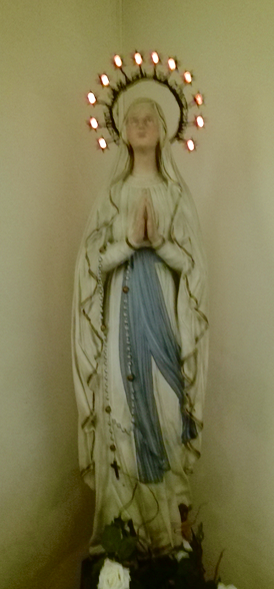
Santa Maria: Virgin, Madonna and Queen
You can’t be in Italy long without having to grapple with how you feel about Mary. Her image is everywhere. There are four key recognisable moments, faces of Mary:
1: Annunciation: Mary as a young girl, the angel taking the initiative, Mary eyes down, passive in her ‘yes’ to God. Often shown with a lily for purity. The most interesting thing about these artworks is where she is placed; it’s cute when she is reading or doing some domestic task, at home or in her garden.
2: Madonna and Child, her holding her baby, who is often depicted as a miniature adult, her attention focused on Jesus, all motherly curves and ‘aroha’. These art works often form a triangular shape, her skirts wide and firmly grounded, her head the pinnacle.
3: Pieta: Images of Madonna holding the dead body of her son are the most anguished. Her face is often rent with agony, turned towards heaven in a ‘why?!’, or looking at Jesus’ closed eyes. In more stylised images her heart is literally pierced by the sword predicted by Simeon.
4: then there are the heavenly images of Mary, raised in glory, in the company of Jesus., bedecked with angels & cherubs, Queen of all the company of heaven. Above the door in the church of St Frances near Silvia & Franco’s place is a large painting (too dark & high to photograph sorry). Jesus sits on the left, holding the cross like a pennant, looking upwards, bathed in light. He reaches out with one hand towards his mother, who is sitting on the right. She looks and reaching down in blessing with one hand toward St Frances, who is crouched below her. Around them angels play music, read books, all drenched in heavenly glow. This, then, is a chain of command, a flow of divinity from ‘light inaccessible’ from above, through Jesus Christ, to his mother Maria, down to the Saint, and from them down to humanity.
5: finally, Mary as Ultimate Saint, standing tall, alone, in white and blue, the essence of devotion, the model of faith, the goddess of peace and sanctity. These statues may be covered with garlands, or objects laid at her feet.
Less common, but rather delightful, images are:
So what do we as Protestants make of all this? Can I relate to her as a woman? Can I relate to her as God? What does my gut-level reaction to these images say about me and my theology?
I observe but do not share the deep heart response of Catholic people to the Madre. I sense in their devotion to her the most fundamental of instincts, the child being held by the mother. What a visceral sense of safety and love. It is personal; Madre Maria knows me, cares for me. Her statue is tangible, touchable. The beads and familiar prayers connect her to us and us to her; “Maria, pray for us sinners now and at the hour of our death”. What did the Reformers do with this most basic of human needs and relationships? Were they guilty of a spiritual matricide, killing off the mother? How can we have only a Father? As our Protestant elders proclaimed the Word, did they lose something of the heart?
So what do I actually believe?
My conviction is that the people who actually knew Jesus first-hand are highly important to us. I treasure all the stories they told about Jesus, and other told about them. It is wonderful that Jesus’ mother was so much a part of the whole story, and that she was respected as a leader in that community. She, and Peter, and Paul, and the 12, and the other Marys, reach out to us through the millennia and invite us to get to know Jesus as they did. So Mary graciously shares with us, with me, her love for Jesus and her knowledge of him, as I learn and imagine – and the Holy Spirit works through this, bringing scripture to life.
My conviction also is that Jesus alone is Christ, Jesus alone is the Son of God and the Son of Man. He alone knew God in the intimacy of Abba, in the perfection of his will and his power. The one I long to know is Christ, and to enter into his relationship with the Father. Only Christ, only through his cross, can bring us to God. Only Christ can send us his Spirit. His mother was a wonderful woman, and I respect her as much as I respect anyone, but Mary was only human. She died and has entered into what ever awaits each of us in the eternal house of God. It is meaningless to me to talk of people being saints or queen or having any kind of special status in the heavenly realms. Those who are in Christ are in Christ, it’s not a hierarchy of holiness. And those who have died have died, and have no further role to play in this earthly drama in which we the living now take centre stage.
All the needs of the human heart, for love, for mana, for achievement, for legacy, for tenderness, for significance or innocence, all these needs are held and met in Christ Jesus. Through his grace and his indwelling Spirit we can experience the divine in a host of ways, all that our imaginations can create, including all these paintings and statues that surround me in this vast ancient church, but they are no more or no less valid that a simple child’s drawing, or a poem that I write, or a fresh loaf of bread or a new Hillsong song. Our imaginings about Mary are no more and no less important than all attempts to narrate ourselves into God’s eternal story.
You can’t be in Italy long without having to grapple with how you feel about Mary. Her image is everywhere. There are four key recognisable moments, faces of Mary:
1: Annunciation: Mary as a young girl, the angel taking the initiative, Mary eyes down, passive in her ‘yes’ to God. Often shown with a lily for purity. The most interesting thing about these artworks is where she is placed; it’s cute when she is reading or doing some domestic task, at home or in her garden.
2: Madonna and Child, her holding her baby, who is often depicted as a miniature adult, her attention focused on Jesus, all motherly curves and ‘aroha’. These art works often form a triangular shape, her skirts wide and firmly grounded, her head the pinnacle.
3: Pieta: Images of Madonna holding the dead body of her son are the most anguished. Her face is often rent with agony, turned towards heaven in a ‘why?!’, or looking at Jesus’ closed eyes. In more stylised images her heart is literally pierced by the sword predicted by Simeon.
4: then there are the heavenly images of Mary, raised in glory, in the company of Jesus., bedecked with angels & cherubs, Queen of all the company of heaven. Above the door in the church of St Frances near Silvia & Franco’s place is a large painting (too dark & high to photograph sorry). Jesus sits on the left, holding the cross like a pennant, looking upwards, bathed in light. He reaches out with one hand towards his mother, who is sitting on the right. She looks and reaching down in blessing with one hand toward St Frances, who is crouched below her. Around them angels play music, read books, all drenched in heavenly glow. This, then, is a chain of command, a flow of divinity from ‘light inaccessible’ from above, through Jesus Christ, to his mother Maria, down to the Saint, and from them down to humanity.
5: finally, Mary as Ultimate Saint, standing tall, alone, in white and blue, the essence of devotion, the model of faith, the goddess of peace and sanctity. These statues may be covered with garlands, or objects laid at her feet.
Less common, but rather delightful, images are:
- Mary’s meeting with Elisabeth, the two women pregnant impossibly, their eyes and hands alight with joy of meeting, as the boys within their wombs simultaneously share in the moment of recognition. This is a very special image, the way their eyes meet, they may be embracing or caught in motion as they are just about to.
- Some artists give expression to Mary’s meetings in the Temple, with Anna or Simeon. These are pointant both in the joy of knowing the significance of her child, but also prophecying her future pain.
- A favourite of the Renaissance artists was Mary with Joseph and Jesus, the Holy Family. Very nice and encircling.
- I’ve seen some of Mary’s death, her soul being received directly by the Holy Trinity.
So what do we as Protestants make of all this? Can I relate to her as a woman? Can I relate to her as God? What does my gut-level reaction to these images say about me and my theology?
I observe but do not share the deep heart response of Catholic people to the Madre. I sense in their devotion to her the most fundamental of instincts, the child being held by the mother. What a visceral sense of safety and love. It is personal; Madre Maria knows me, cares for me. Her statue is tangible, touchable. The beads and familiar prayers connect her to us and us to her; “Maria, pray for us sinners now and at the hour of our death”. What did the Reformers do with this most basic of human needs and relationships? Were they guilty of a spiritual matricide, killing off the mother? How can we have only a Father? As our Protestant elders proclaimed the Word, did they lose something of the heart?
So what do I actually believe?
My conviction is that the people who actually knew Jesus first-hand are highly important to us. I treasure all the stories they told about Jesus, and other told about them. It is wonderful that Jesus’ mother was so much a part of the whole story, and that she was respected as a leader in that community. She, and Peter, and Paul, and the 12, and the other Marys, reach out to us through the millennia and invite us to get to know Jesus as they did. So Mary graciously shares with us, with me, her love for Jesus and her knowledge of him, as I learn and imagine – and the Holy Spirit works through this, bringing scripture to life.
My conviction also is that Jesus alone is Christ, Jesus alone is the Son of God and the Son of Man. He alone knew God in the intimacy of Abba, in the perfection of his will and his power. The one I long to know is Christ, and to enter into his relationship with the Father. Only Christ, only through his cross, can bring us to God. Only Christ can send us his Spirit. His mother was a wonderful woman, and I respect her as much as I respect anyone, but Mary was only human. She died and has entered into what ever awaits each of us in the eternal house of God. It is meaningless to me to talk of people being saints or queen or having any kind of special status in the heavenly realms. Those who are in Christ are in Christ, it’s not a hierarchy of holiness. And those who have died have died, and have no further role to play in this earthly drama in which we the living now take centre stage.
All the needs of the human heart, for love, for mana, for achievement, for legacy, for tenderness, for significance or innocence, all these needs are held and met in Christ Jesus. Through his grace and his indwelling Spirit we can experience the divine in a host of ways, all that our imaginations can create, including all these paintings and statues that surround me in this vast ancient church, but they are no more or no less valid that a simple child’s drawing, or a poem that I write, or a fresh loaf of bread or a new Hillsong song. Our imaginings about Mary are no more and no less important than all attempts to narrate ourselves into God’s eternal story.
The Wrong Ticket
I stuffed up. I was doing my best with the trip planning and doing the internet booking thing and I was booking the train for our trip from Rapallo to Florence, and I got a ticket … but I managed to book the train from Rapolano to Florence instead. My hosts don’t even know where Rapolano is, but it is not here and we are not there to catch the train from there. As we say in kiwi-land: “bugger”.
Thanks, internet!
Obviously my brain isn’t sufficiently wired for details, and in this case making assumptions and hoping for the best really was not going to work.
So, after some futile time and effort expended on the intricacies of the Italy rain system administration, I gave up and bought a new ticket. From Rapallo to Florence. Much better.
But isn’t it a lovely metaphor? Isn’t that just how it is for humanity? We think we know where we are and where we are going, but in our mixed-up state we call ‘sin’, actually, we don’t.
I stuffed up. I was doing my best with the trip planning and doing the internet booking thing and I was booking the train for our trip from Rapallo to Florence, and I got a ticket … but I managed to book the train from Rapolano to Florence instead. My hosts don’t even know where Rapolano is, but it is not here and we are not there to catch the train from there. As we say in kiwi-land: “bugger”.
Thanks, internet!
Obviously my brain isn’t sufficiently wired for details, and in this case making assumptions and hoping for the best really was not going to work.
So, after some futile time and effort expended on the intricacies of the Italy rain system administration, I gave up and bought a new ticket. From Rapallo to Florence. Much better.
But isn’t it a lovely metaphor? Isn’t that just how it is for humanity? We think we know where we are and where we are going, but in our mixed-up state we call ‘sin’, actually, we don’t.
